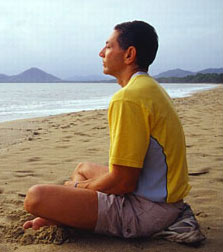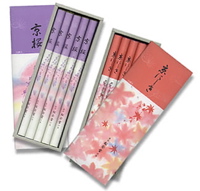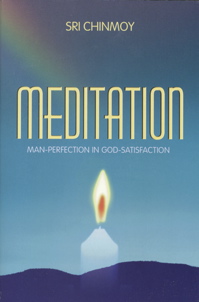The course format
 We begin with the basics of meditation – posture, correct breathing, and mental focus – and then introduce different types of meditation. We offer practical exercises to help you master each stage before progressing to the next one. We enrich our workshops with helpful meditation tips, personal anecdotes and plenty of joy.
We begin with the basics of meditation – posture, correct breathing, and mental focus – and then introduce different types of meditation. We offer practical exercises to help you master each stage before progressing to the next one. We enrich our workshops with helpful meditation tips, personal anecdotes and plenty of joy.
It is important to remember that each person’s soul has its own way of meditating. Because of this, you may find that you will prefer one form of meditation, while friends or family members may prefer something entirely different. The value of a course such as this is to help you go deep within and discover which form of meditation suits you, as an individual.
Some helpful meditation tools
Various things can inspire us to meditate – a beautiful sunset, an exquisite piece of music, the purity of a flower, the deep silence of evening. You can create a meditative environment in your own home very simply. At our workshops, we offer a range of incense to burn during meditation. We also offer recordings of flute music for meditation and books by Sri Chinmoy in which he answers many questions about concentration, meditation and contemplation.
Practice
As with any other endeavour, practice makes perfect. Ideally, it is good to meditate at least twice a day, for fifteen minutes each time. Soon you will start to feel tangible results. For those who wish to continue meditating with us, we hold weekly follow-up classes at our meditation centre in Woodlands. These smaller classes provide you with in-depth personal advice and guidance.

A word from Sri Chinmoy
“When we meditate, what we actually do is enter into a vacant, calm, still, silent mind. We go deep within and approach our true existence, which is our soul. When we live in the soul, we feel that we are actually meditating spontaneously. On the surface of the sea are multitudes of waves, but the sea is not affected below. In the deepest depths, at the bottom of the sea, it is all tranquility. So when you start meditating, try to feel your own inner existence first. That is to say, the bottom of the sea: calm and quiet. Feel that your whole being is surcharged with peace and tranquility.”
Creating a sacred space in your home
SELECT A SPACE
Choose a quiet corner of your home that does not have high traffic and which is not used for another purpose. A desk or kitchen counter is not conducive to meditation because these areas are associated with other aspects of your life. If possible, choose somewhere that is not a thoroughfare and where you will be uninterrupted. The ideal choice would be a small room or alcove you can dedicate just for this purpose. Then you will be able to go there whenever you wish to enjoy its sanctuary.
MAKE THE SHRINE
This will be your focal point. First place a small table or bookshelf in a central position. You may wish to cover it with a special cloth. The most important question is what to place on the table. This is the time to ask yourself if there is anybody who inspires you in your meditation. Is there any spiritual Master who gives you a feeling of profound joy and fulfilment? Some seekers find that a statue of the Buddha in his meditative consciousness inspires them to go deep within. Those who are oriented towards Christianity may prefer something relating to Jesus Christ. An Indian seeker, on the other hand, may choose Sri Krishna or one of the cosmic Gods and Goddesses, such as Ganesh or Kali. In our times, Sri Ramakrishna, Ramana Maharshi and Sri Chinmoy are just some of the spiritual Masters who have attracted sincere seekers of both East and West. By placing a photograph of one of these Masters on your shrine, especially a photograph where the Master is in a very high state of meditation, you will be inwardly guided by that Master.
FLOWERS
Fresh flowers can add immensely to the beauty and vibration of your sacred space. The simple act of placing a flower on the shrine reminds us of our own inner beauty. Sri Chinmoy recommends the following technique for meditating on a flower: “While you are looking at the flower, feel that your breath is entering into it. Then again, feel that the flower has entered into your heart and there it is breathing. Your heart-flower and the flower that you have placed on the shrine are going to and fro, they are constantly interchanging. The flower that is on the shrine is entering into your heart, and again it is coming out to be on the shrine. If you can do this during your meditation, then your heart will become purer than the purest.”
CANDLES
The gentle light of a candle flame also contributes to the meditative atmosphere. The steadiness of the candle flame is a metaphor for the poise that the human mind can attain during meditation. When thoughts come and disturb us, it is like the flickering of the flame. But the true nature of the flame is to rise steadily upwards. “When we see the outer flame,” Sri Chinmoy writes, “then immediately we feel that the flame in our inner being is being kindled and is climbing high, higher, highest.”
the meditative atmosphere. The steadiness of the candle flame is a metaphor for the poise that the human mind can attain during meditation. When thoughts come and disturb us, it is like the flickering of the flame. But the true nature of the flame is to rise steadily upwards. “When we see the outer flame,” Sri Chinmoy writes, “then immediately we feel that the flame in our inner being is being kindled and is climbing high, higher, highest.”
INCENSE
 The delicate fragrance of a stick of incense has a very subtle effect and is one that could easily be overlooked. But it has its own significant contribution to make to your sacred space. Sri Chinmoy explains, “When we smell the scent of incense, we get perhaps only a little inspiration, a little purification, but this inspiration and purification can be added to our inner treasure.” He adds, “If something helps me to dive deep within, then I will accept that help.”
The delicate fragrance of a stick of incense has a very subtle effect and is one that could easily be overlooked. But it has its own significant contribution to make to your sacred space. Sri Chinmoy explains, “When we smell the scent of incense, we get perhaps only a little inspiration, a little purification, but this inspiration and purification can be added to our inner treasure.” He adds, “If something helps me to dive deep within, then I will accept that help.”
MUSIC
Many times, meditation is conducted in sublime silence but you may wish to vary your meditation practice by playing spiritual background music. Music that is suitable for meditation can include flute, gongs, wind chimes, bells or other similarly soothing sounds.
Spiritual reading helps us to enter into a meditative consciousness. It is helpful to have a few spiritual books on hand. It is extraordinary how often we will open the work of a spiritual Master at random, only to find that the Master seems to be talking directly to us and offering a solution to our so-called problems.
JAPA BEADS
The practice of repeating a sacred mantra, such as AUM, Shanti or Supreme is another way to bring stillness into the mind and to make yourself receptive to the highest inner experiences. Different spiritual paths offer different mantras. These sacred words or phrases have been used since ancient times. They have the effect of bringing certain qualities in our nature to the fore — such as wisdom, inner strength, courage and peace. The practice of sitting before your shrine and repeating a mantra several hundred times with utmost intensity is an experience that will change your life forever. You can count your repetitions on your fingertips or by using japa beads. Japa beads are traditionally held in the right hand. Most strings contain exactly 108 beads.
WRITE IN A JOURNAL
Many seekers find that their loftiest inspirations and intuitive realizations come to them during their meditation. That is the time when the surface mind becomes tranquil and we can listen to the promptings of our heart. “The mind is like Times Square on New Year’s Eve; the heart is like a lonely cave in the Himalayas,” says Sri Chinmoy. Record your insights and also your high meditative experiences. If you happen to experience difficulties with your meditation at a future date, it can help tremendously to read your previous uplifting experiences. The ability to write things down is also essential when you are faced with problems or difficulties in your life. Perhaps you have an important life question and you do not know how to answer it. You will find that if you write the question on a piece of paper and place it on your shrine during your meditation, your soul will give you the correct answer in its own time.
HOW TO SIT
How we sit during meditation is determined by what position each individual can sustain without discomfort. Traditionally, Indian seekers meditate either in full lotus or half lotus position. Many Western seekers simply sit cross-legged on the floor. These positions have the advantage of keeping the spine straight, allowing the energy to flow without obstruction. Some seekers find that a zafu, or round meditation cushion, raises the hips and makes it possible for them to maintain a floor position without physical restlessness for a longer period of time. Again, it is not at all necessary to sit on the floor. Sitting in a chair is also a common meditation practice. Most spiritual Masters, however, advise against lying down on the floor. Meditation is a state of intense alertness, not to be confused with sleep or daydreaming.
DE-CLUTTERING YOUR SACRED SPACE
Creating a sacred space depends just as much on what you omit as what you include. This is your chance to leave the outer world at the door. That includes all the distractions and vibrations associated with cell phones, computers, televisions and so forth. Even shoes carry with them vibrations from the places you have been. When you enter your sacred space, it is like entering another world, a world full of purity and beauty. If you take a shower before meditating and put on light, clean clothes it will help you to feel a sense of newness and freshness.
A HOLY PLACE
In time, your sacred space will become a holy place. The more you meditate there, the more it will accumulate a certain height or vibration of its own. You will feel that vibration whenever you enter it and this will help you to enter into your highest meditation more rapidly. Your sacred space will become your haven, your sanctuary, the home of some of your most joyful moments and most fulfilling inner experiences. There all your earthly strains and stresses will be erased. In your daily life, your sacred space will become more essential to you perhaps than your kitchen. It is the expression of your inner self, and as you grow inwardly, so you will spend more and more time there. You may find yourself meditating not only early in the morning, but also at dusk or late at night. Perhaps there shall come a time in your life when you will fully concur with the words of Sri Chinmoy in the following poem:
There was a time
When I needed many things.
But now I need only one thing:
The sanctuary
Of my heart’s silence-truth.
~ SRI CHINMOY
More on Meditation:
- Five Minute Breathing Exercise for Stress Relief
- Stopping the Thought Process
- Music for Meditation
- What Type of Meditation to Choose?
- Meditation Classes in Perth
External Resources:
If you are interested in learning more about Sri Chinmoy, his students and the activities of the Sri Chinmoy Centre, please visit our websites:
www.srichinmoy.org – Here you will find information about Sri Chinmoy, his philosophy and his lifetime of service to humanity.
www.srichinmoylibrary.com – Many hundreds of Sri Chinmoy’s writings are available on this site. You can search by topic and you will be able to read questions and answers, poems, stories and even dramatic works where he explores different themes related to the inner life.
www.srichinmoy.tv – On this site you can watch videos of meditations and interviews with Sri Chinmoy.
www.radiosrichinmoy.org – Here you can listen to the music of Sri Chinmoy and his students. Seekers the world over have found that Sri Chinmoy’s “Flute Music for Meditation” creates an ideal atmosphere for meditation.
www.worldharmonyrun.org – In 1987 Sri Chinmoy founded The Peace Run, a global torch relay to promote peace. The Run takes place every two years and the Australian legs of it are filled with fascinating adventures and scenery. The Run visits many schools on its route and thousands of schoolchildren have held the torch as it passes through their town.
www.srichinmoy-reflections.com – This site is run by a student of Sri Chinmoy in NSW. It contains excellent and informative articles about various aspects of Sri Chinmoy’s life, including his music, art, literature, weightlifting and athletics.
www.incenseworld.com.au – This is a Melbourne-based distributor offering high quality incense from Japan and Tibet. It also carries a good selection of books and musical recordings by Sri Chinmoy.

